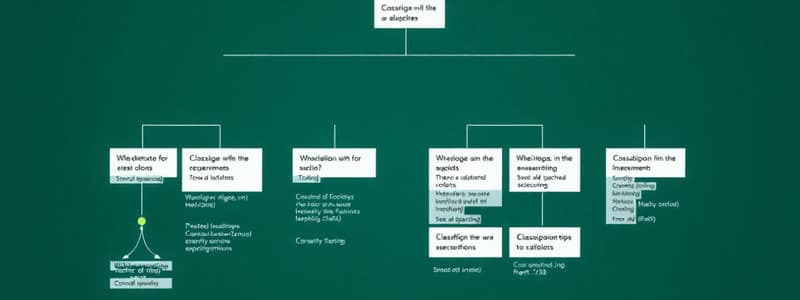Podcast
Questions and Answers
What separates the two classes in a binary classification problem using linear models?
What separates the two classes in a binary classification problem using linear models?
- Line of best fit
- Decision tree
- Decision boundary (correct)
- Regression line
In decision trees, what is usually tested at the nodes?
In decision trees, what is usually tested at the nodes?
- The predicted probabilities
- A random selection of attributes
- The overall classification accuracy
- An attribute compared to a constant (correct)
What typically happens to the outcome for a numeric attribute in a decision tree?
What typically happens to the outcome for a numeric attribute in a decision tree?
- It is not re-tested once used.
- It results in two branches based on a comparison. (correct)
- It results in three branches for each possible value.
- It is treated as a constant.
What should be done with missing values when using decision trees?
What should be done with missing values when using decision trees?
How does a regression tree differ from a linear equation in terms of size and complexity?
How does a regression tree differ from a linear equation in terms of size and complexity?
What does a model tree combine to generate its predictions?
What does a model tree combine to generate its predictions?
What is a characteristic of leaf nodes in decision trees used for regression?
What is a characteristic of leaf nodes in decision trees used for regression?
What is a significant advantage of regression trees compared to linear models?
What is a significant advantage of regression trees compared to linear models?
What characterizes the antecedent in classification rules?
What characterizes the antecedent in classification rules?
What problem can arise with unordered rule sets?
What problem can arise with unordered rule sets?
What is the primary limitation of classification rules compared to association rules?
What is the primary limitation of classification rules compared to association rules?
What is typically sacrificed in ordered rule sets?
What is typically sacrificed in ordered rule sets?
Why are rules with exceptions beneficial in a ruleset?
Why are rules with exceptions beneficial in a ruleset?
What does a classification rule do when no classifications apply to a given example?
What does a classification rule do when no classifications apply to a given example?
What does the term 'replicated subtree problem' refer to in the context of rules?
What does the term 'replicated subtree problem' refer to in the context of rules?
Which of the following statements about support and confidence in association rules is correct?
Which of the following statements about support and confidence in association rules is correct?
What is a significant feature of exceptions in rule-based classification?
What is a significant feature of exceptions in rule-based classification?
Which aspect of nearest-neighbor learning is important for its implementation?
Which aspect of nearest-neighbor learning is important for its implementation?
What does instance-based representation fail to explicitly represent?
What does instance-based representation fail to explicitly represent?
How do rectangular regions in instance-based methods relate to rules?
How do rectangular regions in instance-based methods relate to rules?
What is a drawback of instance-based representation in machine learning?
What is a drawback of instance-based representation in machine learning?
In instance selection, why might it be unnecessary to store all training instances?
In instance selection, why might it be unnecessary to store all training instances?
What is one common misconception about rules in machine learning?
What is one common misconception about rules in machine learning?
What is the main advantage of using exceptions in complex rule sets?
What is the main advantage of using exceptions in complex rule sets?
Flashcards
Decision Boundary
Decision Boundary
A line or hyperplane produced by a linear model in binary classification problems that separates the two classes.
Decision Tree
Decision Tree
A tree-like structure where each node represents a test on an attribute and each branch represents the possible outcomes of that test. Leaf nodes represent classifications or probabilities.
Nominal Attribute
Nominal Attribute
An attribute with a set of discrete values that have no inherent order.
Numeric Attribute
Numeric Attribute
Signup and view all the flashcards
Missing Value Handling
Missing Value Handling
Signup and view all the flashcards
Regression Tree
Regression Tree
Signup and view all the flashcards
Model Tree
Model Tree
Signup and view all the flashcards
Continuous Function
Continuous Function
Signup and view all the flashcards
Consequent
Consequent
Signup and view all the flashcards
Antecedent
Antecedent
Signup and view all the flashcards
Classification Rules
Classification Rules
Signup and view all the flashcards
Association Rules
Association Rules
Signup and view all the flashcards
Support and Confidence (Association Rules)
Support and Confidence (Association Rules)
Signup and view all the flashcards
Decision List
Decision List
Signup and view all the flashcards
Unordered Rule Sets
Unordered Rule Sets
Signup and view all the flashcards
Rules with Exceptions
Rules with Exceptions
Signup and view all the flashcards
Exceptions in Rules
Exceptions in Rules
Signup and view all the flashcards
Rule Expressiveness
Rule Expressiveness
Signup and view all the flashcards
Secondary Attributes
Secondary Attributes
Signup and view all the flashcards
Lazy Learning
Lazy Learning
Signup and view all the flashcards
Instance-Based Learning
Instance-Based Learning
Signup and view all the flashcards
Distance Metric
Distance Metric
Signup and view all the flashcards
Instance Selection
Instance Selection
Signup and view all the flashcards
Explicit Representation
Explicit Representation
Signup and view all the flashcards
Study Notes
Output Knowledge Representation
- Tables are used to represent knowledge, such as weather data
- Decision tables or regression tables are examples
- Tables may involve selecting a subset of attributes
Output: Linear Model
- Linear models, like CPU performance, can be used
- In binary classification problems, the model produces a line that separates the two classes (decision boundary)
- The line can be compared to a hyperplane in higher dimensions
Trees
- Decision trees are used for knowledge representation (contact lens, labor)
- Nodes test attributes, often by comparisons with constant values
- Leaf nodes provide classifications or probabilities
- Nominal attributes are not usually re-tested while numerical attributes may be re-tested later
- Testing numerical attributes creates two branches (< constant, >= constant), but there is also a third for missing values
- For real-valued data, exact equality is rare
- Intervals are often specified (Above, Within, Below)
- Missing values have their own branches
- Decision trees allow for alternative splits (option nodes)
Decision Trees for Regression
- For numeric outcomes, each leaf node contains the average of training instances reaching that branch (regression tree)
- Regression trees are more complex
- However, generally more accurate than linear equations, especially for non-linear data
- Tree structures are more complex than linear equations, but are usually more accurate for data that aren't perfectly linear
- More complex than linear equations but easier for comprehension
Model Tree
- Combining regression equations and regression trees is possible
- Leaves in a model tree contain linear expressions
- Model trees model continuous functions using linear patches
- Model trees are smaller and easier to understand, often more accurate
Output: Rules
- Antecedents form the conditions (often conjunctions)
- Consequents are classes or probability distributions
- This system includes Classification Rules and Association Rules
Classification Rules
- Classification rules can be derived directly from a decision tree
- Rule sets can be more complex than necessary
- Simplifying the ruleset is possible through pruning
- It isn't always easy to generate a tree from rules
Replicated Subtree Problem
- A decision tree may contain replicated subtrees, leading to inefficiency
Exclusive-Or Problem
- This problem is exemplified by a figure, illustrating patterns of dependent conditional statements
Rules
- Rules are a popular choice due to the independent nature of each new rule
- Individual rules can be added to an existing ruleset without needing to re-structure the entire set
- However, rules may have conflicts, requiring order or a conflict resolution algorithm for an ordered rule set or an unordered rule set, requiring conflict resolution
Unordered Rulesets
- Multiple possible classifications exist for a given example
- A lack of classification or using the most probable outcome from training data
- No classification applies: using the most frequent class
Simple Example
- Boolean classes don't allow conflicts.
- All outcomes are expressed with the assumption of a closed world.
Exceptions
- Fixing rule sets is more complex than expected
- Changing boundaries might re-classify existing examples and some previously good exceptions could be bad exceptions.
- Expert input may be required to identify and fix exceptions
- Exception clauses can be established to adjust rule sets incrementally
More Expressive Rules
- Further examples are presented elsewhere to illustrate more expressive rules
Instance-Based Representation
- Lazy learning vs. eager learning (nearest-neighbor k-value)
- Distance metric (Euclidean distance often used with normalized data)
- Nominal attributes require considerations in the distance metric
- Training instance selection
Instance Selection
- Not all training instances must be stored
- Regions of attribute space are more stable than others
- Fewer samples are needed for stable regions
- More exemplars near class boundaries
IBL (Instance-based Learning)
- Instance-based methods don't explicitly detail the learning structure
Rectangular Regions
- Rectangular regions are similar to rules but often are more conservative
Prototypes
- Nearest-Prototype method(s)
- Using Prototypes instead of Neighbors
Cluster
- When using clustering rather than classification, the output is a diagram showing how instances group.
Multiple Membership
- Instances can belong to more than one cluster.
- Data represented with Venn Diagrams
Probabilities or Fuzzy Memberships
- Clusters can be associated with probabilities or fuzzy membership degrees
Hierarchical Clusters
- Some algorithms implement hierarchical structures
- Showing the hierarchical relationship is often shown with a dendrogram
Clustering
- Clustering operations might be followed by stages that associate instances to clusters using rulesets or decision trees
Studying That Suits You
Use AI to generate personalized quizzes and flashcards to suit your learning preferences.




